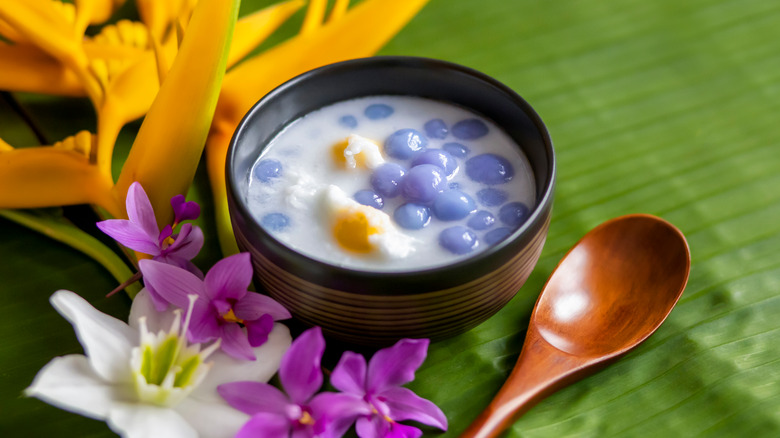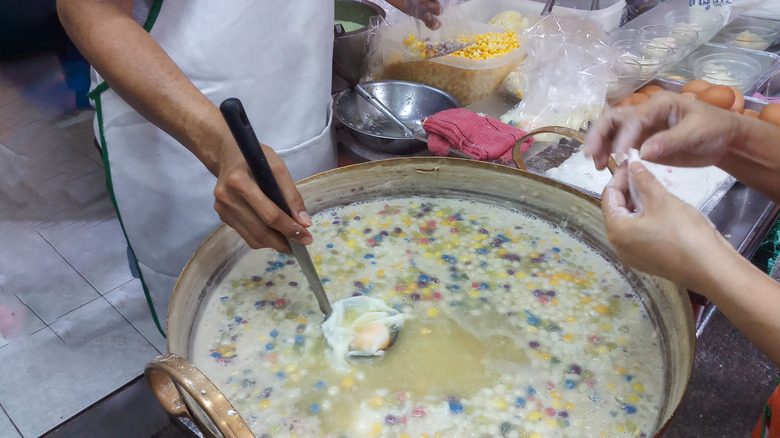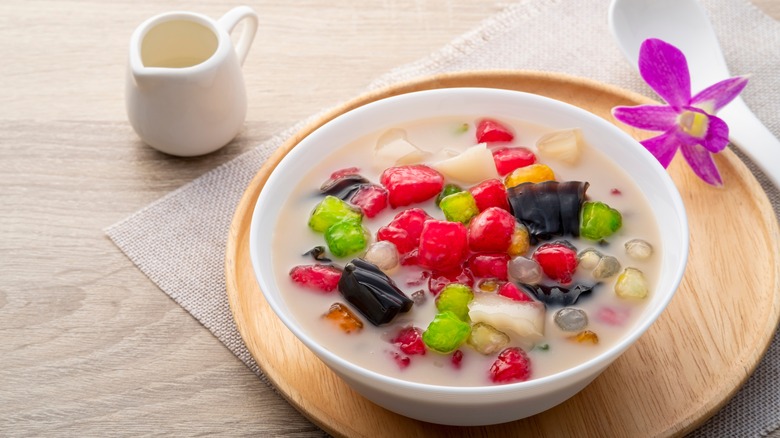Bua Loy: The Floating Thai Dessert You Should Know
Thailand's rich cuisine is world famous, thanks in part to deliberate effort on the part of the Thai government to promote dishes across the globe (via Splendid Table). However, authentic Thai food is more complex and nuanced than much of the standard fare you'll find in Europe or America.
As the Institute of Culinary Education explains, authentic Thai food has a unique take on flavor. While Thai cuisine varies significantly by region, an overarching theme is an emphasis on creating harmonious taste. Playing off influences from around the world, Thai food combines ingredients in unique ways to create dishes unlike anything you'll find elsewhere.
Thai food is based on five essential flavors: salty, sweet, sour, bitter, and spicy. Most authentic Thai dishes combine at least two of these flavors, allowing the tastes to play off each other. While desserts — which often feature native fruits like mango, lychee, banana, and coconut in addition to ingredients like tapioca and rice flour — may forgo the spicy flavors found in recipes like shrimp pad thai, they still employ the country's unique take on flavor to create a harmonious whole.
One such dessert is bua loy. As Thaitable.com explains, bua loy is made up of rice balls floating in coconut milk and delivers a sweet and salty flavor profile. This subtle dessert looks as charming as it tastes.
What is bua loy?
As C. Hawj Creations explains, bua loy is a traditional Thai dessert comprised of small, chewy, brightly-colored balls of glutinous rice flour floating in sweetened coconut milk. When served with poached egg, the desert is called bua loi kai wan — a traditional Thailand dish that must be tasted.
Presentation is important in Thai cuisine, and bua loy makes quite a statement. While the colors seem artificial — and can be enhanced by food coloring — natural plants are all you need to create rainbow-hued rice balls. The pandan leaf, as an aromatic plant found in Southeast Asia, lends a bright green hue and vanilla flavor to bua loy dishes (via Healthline). Ube creates a joyful purple color, and butterfly pea flower turns rice balls a vibrant blue. For fuchsia, dragonfruit powder can be added to dough. However, there's no need to stop there: The simplicity of bua loy makes it ripe for experimentation, as it is a recipe that can be enhanced with different ingredients and flavor combinations.
How is bua loy made?
Thai cooking blog C. Hawj Creations insists bua loy is strikingly simple to make. Combine glutinous rice flour with hot water, flavorings, and some starch — either tapioca or starchy vegetables. Once you've formed a pliable dough, roll small balls and boil them in water until they float to the surface. Then, heat the coconut milk that's been in your pantry and add salt and palm sugar to create a syrupy broth. Add the rice balls to the broth and serve the dish hot. It's that easy.
Be careful to avoid one crucial mistake, however: use the right kind of flour. Serious Eats notes that the recipe only works with glutinous rice flour, so double-check to make sure you're not using regular rice flour. According to MasterClass, glutinous rice flour is distinctly different from rice flour and makes a big difference in texture; glutinous rice flour has a chewy texture that gives dishes like mochi and bua loy their signature squish. Despite its name, glutinous rice flour doesn't actually contain gluten — instead, the name refers to its ability to mimic gluten's stickiness.
Bua loy and tub tim krob
Tub tim krob, which translates as "crispy rubies," might look similar to bua loy at first glance. Though both dishes feature gelatinous, brightly-colored balls floating in coconut milk, the desserts are distinctly different. According to Thai Table, Tub tim krob is made from pieces of water chestnut boiled in red syrup and coated with tapioca flour to form a gelatinous shell. The result is a refreshing dessert with a unique texture that is crunchy, yet chewy. In contrast to bua loy, which is often served hot, tub tim krob is typically served on ice.
Travel Food Atlas explains that these crispy rubies are sometimes added to ruam mit, a versatile Thai dessert also centered on iced coconut milk. Ruam mit doesn't have a set recipe, but it combines a hodgepodge of popular and traditional Thai ingredients. If you order a bowl of ruam mit, you may find ripe jackfruit, lotus root, sweet potato, or colorful tapioca noodles floating in your bowl.



